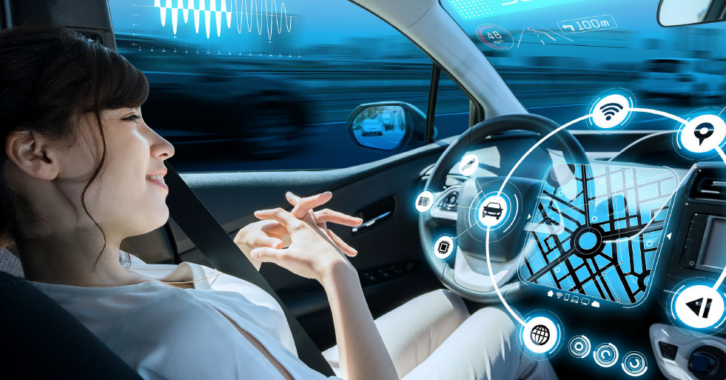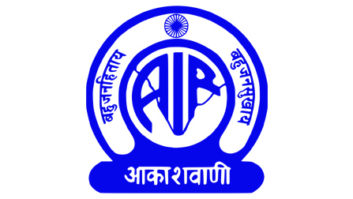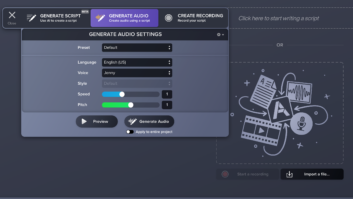
Research shows consumer enthusiasm for using home smart speakers has tempered as that space matures; according to recent data 41% of U.S. households already own a smart speaker.
But the integration of voice assistants into automobiles is opening new avenues for how drivers and passengers interact with the dashboard.
On-demand voice assistants like Google Voice, Siri, Alexa and Samsung’s Bixby enable users to communicate directly by voice to connect to their favorite audio services, including audio streams, podcasts and live radio at home or in the car. At a basic level, a voice assistant replaces or supplements a visual interface and leverages the available data.
This winter’s CES show put a razor focus on voice solutions and their exceptional compatibility with the infotainment-rich in-cabin experience the connected car is delivering. It’s a voice revolution in the car, according to industry observers.
Auto manufacturers and tech developers are unveiling hyper screens in the dash with multi-faceted entertainment packages that can offer hands-free access to on-demand content.
Consumer adoption of voice bots in the vehicle is accelerating, and there are lots of options.
BMW introduced its new AI voice assistant, named Dee, at CES. Mercedes Benz unveiled its new in-car entertainment tech, the semi-autonomous DrivePilot system, which uses voice technology to integrate operating systems with and dashboard control.
Chrysler has been touting its Smart Cockpit infotainment system in its electric vehicles, which includes a virtual personal assistant to “provide personalized recommendations and easier car-to-phone synchronization.” The infotainment system was developed in collaboration with Foxconn Technology Group, according to a press release from the automaker.
The integration of voice control for autonomous mobility and infotainment with voice-activated apps is magnifying the importance for radio broadcasters to be watching the space closely.
“Voice assistants will have a major influence on the in-car experience. And it’s all about access. Using voice in the car is only natural,” said Roger Lanctot, director, automotive connected mobility for TechInsights.
Many auto makers are using Cerence’s solution to create dedicated/branded voice assistants, Lanctot said, for everything from accessing radio stations to operating in-vehicle systems like air conditioning or as digital owner’s manuals.
SoundHound, Inago and SapientX are other names appearing in the voice-based system space, he said.
“Voice in the car is like the car’s search engine — so that means enabling search for things like gas stations and restaurants,” Lanctot said.
“Ultimately voice will allow for greater discoverability of content — types of music, specific artists or tracks, or particular programs or just traffic or weather information — tuned to the vehicle’s location.”
iHeartMedia listed a variety of new affiliations with voice assistant providers this winter. Among them is Cerence, which is being used to deliver “new and innovative paths to access iHeartRadio’s full portfolio of audio content to automakers and their drivers,” according to an iHeartMedia announcement.
“When combined with its industry-leading voice recognition and natural language understanding, Cerence unlocks a seamless iHeartRadio infotainment experience that automakers and mobility OEMs can leverage to delight their drivers across the country.”
iHeart is moving quickly to adopt automotive voice tech that enables a “collaborative experience” in the car, according to the company. Native Voice is another on-demand voice assistant it is using; it enables users to direct connect to content like podcasts and radio station streams. iHeart also highlights a partnership with TomTom and its Digital Cockpit system that integrates iHeartRadio in a car without the user connecting a smartphone to the dashboard.
John Vermeer, executive VP of digital distribution and platform partnerships for iHeartMedia, says voice assistant technology has acted as a gateway to new consumer behaviors and listening occasions for radio, podcasts and music.
“As the efficacy of AI technology continues to improve, new distribution endpoints emerge, and consumers become more comfortable interacting with content providers and brands via voice. We believe we are just getting started,” Vermeer told Radio World in an email.
iHeart is focused on benefitting from any artificial intelligence that can reduce the friction between when a consumer decides to seek out a piece of content and the moment the audio begins, he said.
“We have already been experimenting with voice as a means of allowing consumers to seek out new content and interact with our stations and personalities, but we will continue to test and provide our audiences with new ways to navigate the listening experience across all of our content types,” Vermeer continued.
“We are working closely with numerous partners in the voice space as well as automakers themselves on solutions that are focused on this use case. However, we are increasingly seeing conversant AI become a part of consumers’ daily lives on smartphones, earbuds, smart speakers and other connected devices.”
As radio broadcasters brace for the long-term impact of the connected car, they need to sort out their metadata assets from station and program IDs to digital advertising to make it searchable and discoverable via voice technology, according to Fred Jacobs, president of Jacobs Media.
He has used the phrase “Internet of Things at 65 miles per hour” to describe recent dashboard developments.
“Radio station on-air and website promotion for smart speakers has been very effective. The smartest digital assets for broadcasters include voice assistant collaborations. Amazon has worked very hard to get Alexa into cars and so have others,” Jacobs says.
“Consumers like the personalization voice assistants offer. In a sense they develop a relationship that learns consumer tastes and preferences.”
He acknowledges that sales of home smart speakers is slowing in the consumer electronics sector, which could be bad news for radio broadcasters, since listening to radio is one of the top uses for home smart speakers. But he says radio is better positioned for success in digital dashboards because of consumer awareness of voice assistants.
“Voice assistant technology is definitely in sync with where the connected car is going. The burgeoning dashboard of new cars is the new battleground for radio to remain relevant, and AI is a big part of it.”
Xperi’s DTS AutoStage, a hybrid radio platform that can switch between over-the-air radio signal to IP stream when out of range, was demoed as part of the Garmin Unified Cabin at CES 2023.
Garmin’s concept, based on the Android Automotive operating system, includes four infotainment touchscreens, an instrument cluster and cabin monitoring system.
Joe D’Angelo, SVP of broadcast and digital audio for Xperi, said, “Voice assistants represent a critical technology in today’s media rich connected cars. With more and more choices of platforms and programming, navigating through menus of content in traditional visual formats is not practical or safe during vehicle operation.”
The HD Radio developer works with Tier One suppliers and OEM product developers to ensure that content available via DTS AutoStage is presented in an intuitive and easy-to-discover way, he said. That includes support for the leading consumer and automotive voice interfaces.
Drivers can use DTS AutoStage to “accurately find the desired radio station, show, song or live event” utilizing voice, D’Angelo said.
In addition, Xperi provides an Natural Language Understanding solution with expertise or specialty in media.
“This is extremely important, as media can be referenced in number of ways, and getting to the right program the driver desires is not trivial. We are leveraging years of experience in the video space from our TiVo platforms to ensure that radio and audio services are as easily discovered and presented to drivers.”
Home smart speakers can now be found in about 50 million U.S. homes. But the proliferation of voice assistant technology does come with privacy concerns for users; and observers say collection data and analytics will be ramped up even more so in connected vehicles. That’s good for businesses that have access to the data, but not so appealing to the users.
In fact, the latest trend in voice solutions is built-in security features that make users feel safer, according to observers. But from tracking apps on smartphones that follow driving habits to the Facebook sharing online shopping preferences, data remains the goldmine for developers.
“Privacy is a fantasy, and most consumers understand that,” one source commented. “Just look at Google. We offer up our privacy every day in order to have great search results. And don’t get me started on Twitter and Instagram. Privacy? In your dreams.”












